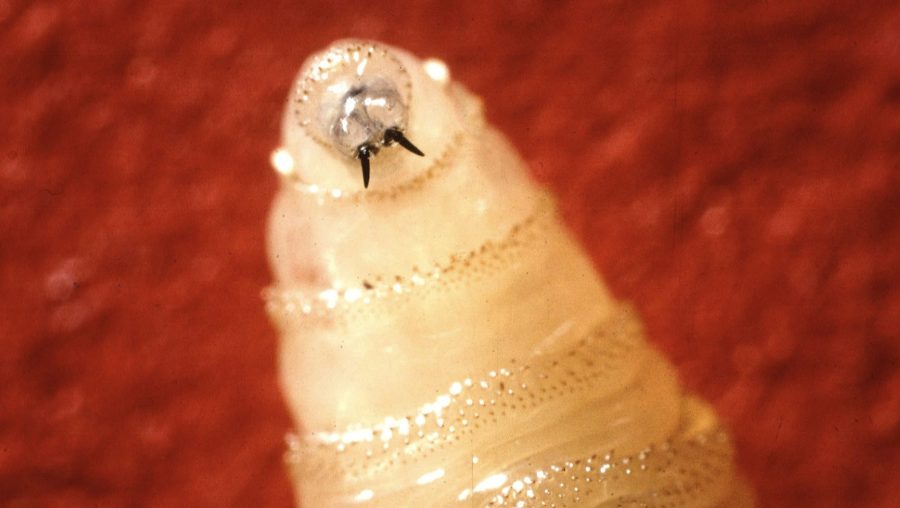Science
High-Tech Solutions Emerge as Screwworms Approach Texas Border

New World Screwworms, an invasive and flesh-eating maggot, are advancing towards the Texas border, raising significant concerns among state and federal officials. The U.S. Department of Agriculture (USDA) has confirmed sightings of these harmful larvae, which burrow into the fresh wounds of living animals, including livestock and pets. The potential damage they cause can be fatal, prompting urgent responses from authorities.
During a press conference on August 15, 2025, Texas Governor Greg Abbott and U.S. Secretary of Agriculture Brooke L. Rollins outlined their strategy to halt the screwworm’s progress. A sterile fly production facility is currently under construction in Edinburg, Texas, aimed at preventing the infestation from spreading. Despite these efforts, reports from the USDA indicate that the screwworm has already been detected in Sabinas Hidalgo, approximately 70 miles from the U.S./Mexico border.
Sid Miller, the Texas Department of Agriculture Commissioner, emphasized the urgency of the situation, stating, “We’ve got this thing, it’s 70 miles from Laredo, it’s at our back door.” Miller has requested the deployment of TDA Swormlure, a bait that could assist in pesticide application to combat the infestation. Meanwhile, researchers are exploring advanced technological solutions to address the threat.
Innovative approaches are emerging as potential game-changers in the battle against New World screwworms. Suresh Pilai, director of the National Center for Electron Research, is leading a project that aims to use electron beams to sterilize screwworm flies. This method offers an alternative to traditional sterilization techniques that involve radioactive isotopes. Pilai described the process, stating, “We basically take electrons, electricity accelerated to 99.8% the speed of light, and then they are highly energetic.” The new technology is set to be tested by October 2026 at the Edinburg facility.
While Pilai’s technique is being developed, existing technologies are already available to assist ranchers in managing their cattle herds. Ceres Tag, a tracking system designed for livestock, allows ranchers to monitor their animals’ locations and behaviors using GPS technology. This smart tagging system, which attaches to the ear of cattle, can help identify potential screwworm infections.
David Smith, founder and CEO of Ceres Tag, explained the functionality of the system, noting, “We’re able to use the sensor that attaches to the ear, in a smart tag form, to monitor their activity and their location.” He added that the technology can indicate if an animal has been infected, as affected cattle often separate from the herd and reduce their feed intake.
Despite the promising capabilities of Ceres Tag, Smith highlighted the limitations of tracking alone. “Tracking of the animal is really only one small piece of the puzzle,” he noted. Marty Jefferson, representing Global Star, echoed this sentiment, stating that predicting cattle grazing patterns remains a challenge. Smith clarified that while their technology provides crucial information, it does not serve as a complete solution to the threat posed by screwworms.
As the situation develops, Texas officials and researchers are committed to implementing both traditional and innovative strategies to safeguard livestock and prevent the spread of New World screwworms. The urgency of the matter underscores the need for continuous monitoring and adaptation as new technologies emerge in the ongoing battle against this invasive species.
-

 Technology5 months ago
Technology5 months agoDiscover the Top 10 Calorie Counting Apps of 2025
-

 Technology2 weeks ago
Technology2 weeks agoOpenAI to Implement Age Verification for ChatGPT by December 2025
-

 Health3 months ago
Health3 months agoBella Hadid Shares Health Update After Treatment for Lyme Disease
-

 Health3 months ago
Health3 months agoAnalysts Project Stronger Growth for Apple’s iPhone 17 Lineup
-

 Health3 months ago
Health3 months agoErin Bates Shares Recovery Update Following Sepsis Complications
-

 Technology5 months ago
Technology5 months agoDiscover How to Reverse Image Search Using ChatGPT Effortlessly
-

 Technology3 months ago
Technology3 months agoElectric Moto Influencer Surronster Arrested in Tijuana
-

 Technology2 months ago
Technology2 months agoDiscover 2025’s Top GPUs for Exceptional 4K Gaming Performance
-

 Technology5 months ago
Technology5 months agoMeta Initiates $60B AI Data Center Expansion, Starting in Ohio
-

 Technology5 months ago
Technology5 months agoRecovering a Suspended TikTok Account: A Step-by-Step Guide
-

 Health5 months ago
Health5 months agoTested: Rab Firewall Mountain Jacket Survives Harsh Conditions
-

 Lifestyle5 months ago
Lifestyle5 months agoBelton Family Reunites After Daughter Survives Hill Country Floods





















